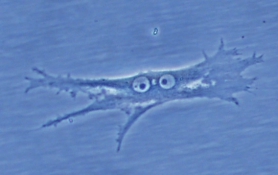
Using Next Generation sequencing techniques, the ocular oncology lab then discovered that inactivating mutations in the tumor suppressor gene BAP1 are responsible for metastasis of class 2 tumors. Further work in the lab showed that a class of therapeutic compounds called histone deacetylase inhibitors can reverse the biochemical effects of BAP1 loss and may play a role in the clinical care of cancer patients. Clinical trials are in the planning stages to test this hypothesis.
Discovery of mutations in BAP1 by the ocular oncology lab has led to the discovery of the BAP1 familial cancer syndrome, which is transmitted in an autosomal dominant fashion and can include uveal and cutaneous melanoma, atypical cutaneous nevi, mesothelioma, meningioma, lung and breast cancer, and several other cancers. A clinical genetic test is being developed for screening high risk families.
The two major research directions in the lab are: (1) continue to use genomic techniques to identify new genetic alterations associated tumor initiation and progression in major forms of eye cancer, and (2) use cell-based and experimental models to understand the biological significance of these genetic alterations.